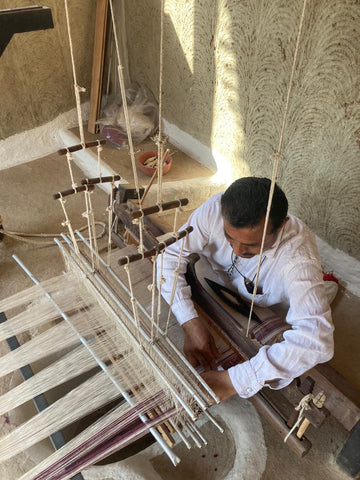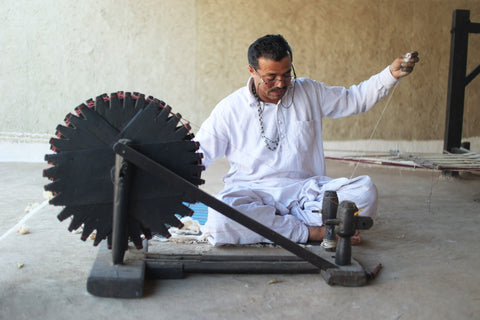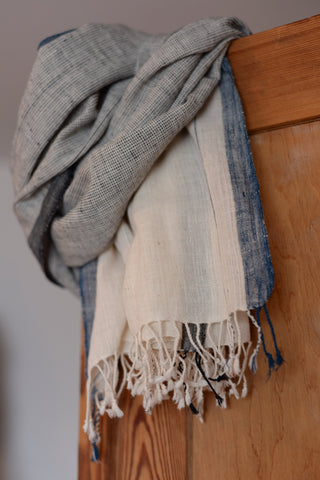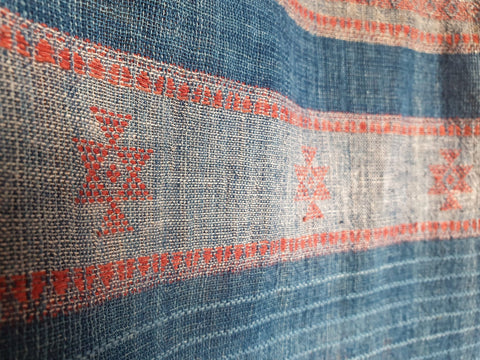
Vankar Shamji Vishram weaves on a pit loom at his home in Bhujodi Village.
India's rich tradition of hand weaving, celebrated for its unique regional patterns, thrives in the Kachchh district of Gujarat in Bhujodi village. This small weaving community is renowned for its traditional handwoven textiles and is the birthplace of Master Weaver Shamji Vankar Vishram Valji. Shamji Bhai, an accomplished artisan, actively collaborates with indigenous communities to preserve India's heritage in artisanal textile crafts.

Shamji Bhai in the indigo dye house at his home.
Carrying on the legacy of his award-winning father, Shamji Bhai works with 90 weaving and dyeing families, producing traditional and modern fabrics from cotton, wool, and silk in collaboration with local and international designers. Bhujodi weaving uniquely employs inlay techniques ("extra-weft") that resemble embroidery, showcasing Shamji Bhai's expertise in utilizing local indigenous varieties of wool and cotton, along with natural dyes like indigo.
A handwoven Bhujodi shawl, made using indigenous Kala Cotton and dyed with natural indigo and lac dyes. Private collection.
'My father had got a National Award in 1974 and my elder brother in 1999. This fuelled me to push for excellence in our craft and in the year 2005 I got a National Award for my creation in natural dyes, using cotton and silk yarns. The same year I also got a World Craft Council Award for Excellence in my craft.'
Vankar Shamji Vishram

The natural indigo vats are kept at a constant temperature underground to maintain a state of fermentation.
We first visited Shamji Bhai at the end of March in 2018. We had travelled to Kachchh for the first time, with 3 of our children, taking the train from Mumbai to Ahmedabad, and then further to Bhuj, staying in a village nearby. On the train, we passed through salt farms, and as we got closer to our destination, beautiful pomegranate orchards. The late March sun beat down, reaching 40 degrees and beyond, and we raced and bumped along dusty roads in sturdy vehicles.

Akshayan looks out into the desert plains in Kachchh, near Bhujodi village. March 2018.
'I used to sit with my father and listen to the stories of our ancestors and our traditional weave. I learnt about the challenges they faced and the leadership he had taken for the community. I understood from him that our family had a sense of responsibility as a few weavers were depending on us for work through the market channels that our father had created. I told my father that I would prefer to weave and continue with our traditional folk art than working outside - though I could have got a good job with my educational qualifications at that time. He was happy with my decision.'
Vankar Shamji Vishram

Shamji spins cotton on a traditional charkha (spinning wheel).
A shuttle holds a bobbin wound with yellow yarn, sitting ready to race back and forth through the warp threads on a pit loom in Bhujodi Village. Photo: Arindam Bhattacharjee, June 2023

Cotton wound onto a warping board in Bhujodi Village. Photo: Arindam Bhattacharjee, June 2023
Kachchh is a region in India that has a very rich and well known craft presence both domestically and internationally; Bhujodi and Tangaliya weaving, Ajrakh block prints, Kharad carpets, Bandhani (a tie-dye technique) and bell making. The region is also known for Kala cotton, a sustainable rain fed indigenous cotton, that requires no pesticides.

A shawl from Shamji Bhai's collection made from indigenous Kala cotton available at BOTHO in Tübingen. Photo: Sarah Dunn, March 2024
Bhujodi village is about 500 years old and is home to around 4000 people. Almost every home has a loom, evidence of both the vibrant cottage industry and age-old textile traditions. The community can trace their roots back to Weavers (Vankars) from the Meghwal community who migrated from Rajasthan 500 years ago. Their traditional wool veils and heavy woollen hand-spun blankets were made for the local Rabari community, used by the shepherds for protection from the harsh sun and cold nights of the desert.

Two of Shamji Bhai's shawls made using indigenous wool (Desi Oon), with the traditional border and extra weft motifs, and hand tied tassles. Photo: Sarah Dunn, March 2024
Stay tuned for Part II: Visiting Bhujodi Village and Master Weaver Shamji Vishram
We are incredibly delighted to share that Shamji Bhai will be joining us here in Germany at the end of April and beginning of May for a series of workshops, lecture demonstrations and a trunk show. For information and sign up, click the following link:
INFO & SIGN UP


